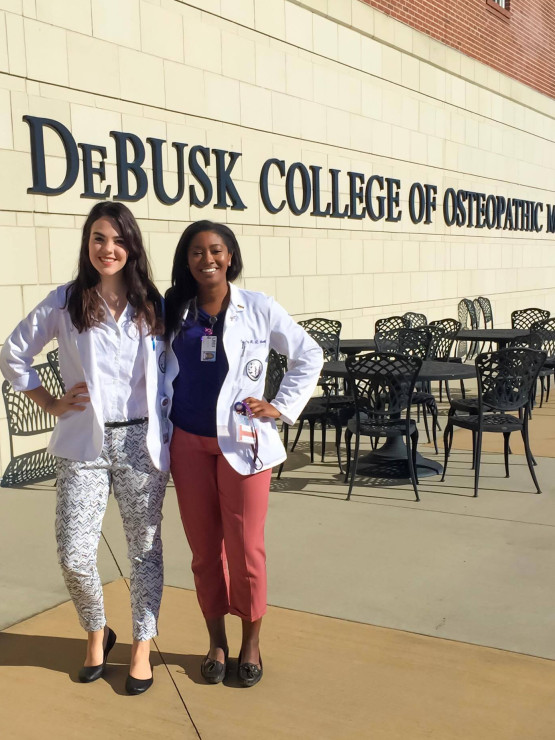Licensed physicians in the United States are either Doctors of Medicine (MDs) or Doctors of Osteopathic Medicine (DOs). Cortney Booth, C’12 and student at DeBusk College of Osteopathic Medicine, addresses the question of whether to apply to a DO program or an MD program.
MD or DO?
August 21, 2017
by Cortney Booth, C'12

Katherine Mustafa, C'14 and Cortney Booth, C'12
One of the biggest questions I had when applying to medical school was “Should I become an M.D. or a D.O?”
Initially I was apprehensive about venturing down the path to become an Osteopathic physician. Much of that hesitancy was due to a stigma I’ve always heard that becoming an Osteopath was lesser than being an Allopath, and some was due to the simple fact that I had always envisioned my name with an M.D. behind it. At the time I really just wasn’t sure that I wanted to stray from that vision. Yet I am ecstatic that I did! As I hit the halfway point through my second year at DCOM, I realize that the tenets of osteopathic medicine—seeing the person as a unit composed of mind, body, and spirit and understanding that the body is capable of self-regulation, self-healing, and health maintenance—are exactly the way I want to approach medicine.
The Doctors of Osteopathic Medicine organization states, “Osteopathic physicians focus on prevention, tuning into how a patient’s lifestyle and environment can impact their wellbeing. DOs strive to help their patients be truly healthy in mind, body and spirit — not just free of symptoms.” This is how myself and my osteopathic classmates plan to practice medicine because this is how we live life every day. While like traditional allopathic clinicians we learn to treat the same diseases and alleviate the same problems once they arise, we as osteopaths take patient care a step further. We bring a focus to mental wellbeing, nutritional wellbeing, and preventative medicine, educating and guiding our patients to prevent disease before it begins. We don’t see the patient as a set of lab data or a series of symptoms, but as a whole being who can be influenced by many factors.
Another difference in DO school is the teaching of osteopathic manipulative treatment (OMT). According to the Doctors of Osteopathic Medicine organization, OMT is “a set of techniques used to treat and prevent illness and injury… [and] can be used to complement, or even replace, drugs or surgery”. In lab I learn new treatments every week that I can use to treat patients in-office. I mean, how great is it to know how to release a cramped muscle or drain a patient’s blocked sinuses without using drugs?
Honestly, if there is one thing I’ve learned since beginning this journey of becoming an Osteopathic physician, it’s that nothing can hold you back but you. Osteopathic physicians are present in EVERY specialty, if you study hard and do well in classes and on board exams, you can go into any specialty, no matter if you are MD or DO. I believe that patient education and preventative medicine are the two most important aspects of medicine, and I know that my osteopathic degree and its patient-centered model of health care will better prepare me to treat my patients.

